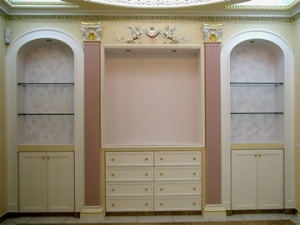
Corinthian Pilaster Column 001
REF. Num:SP 001
Fluted gypsum plaster pilaster column in Corinthian style; consists of 3 parts : capital, shaft and base.

Pilasters were favourite elements in Ancient Rome and Italian Renaissance architecture. Since then pilasters have been used to enrich the interior in wall decors, fireplaces design, door and window surrounds, built-in cabinets and library systems.
The most popular types of pilaster shaft are fluted and paneled. Flutes in a classical order are closely spaced and all have the same length. In our catalogue we have plain capitals for pilasters in modern and neoclassical style and capitals with ornamental Ionic and Corinthian details.
Because pilasters usually project from the wall a distance equal about a third of its width (or less), a pilaster has an appearance of a full, square column, that was embedded into the wall. In fact, earlier pilasters actually were embedded columns that help support an arch. But this structural aspect of the pilasters is merely an effective illusion. Pilaster components are: pilaster base, pilaster shaft and pilaster capital.
You can look at pilaster columns shown in our online catalogue and choose the ones which suit your style.

REF. Num:SP 001
Fluted gypsum plaster pilaster column in Corinthian style; consists of 3 parts : capital, shaft and base.

REF. Num:SP 002
Fluted pilaster column in neoclassical style; consists of 3 parts : capital, shaft and base

REF. Num:SP 003
A pilaster column in Ionic Order with a capital and base, W=22.5 cm

REF. Num:SP 004
A pilaster column in Ionic (Greek) Style, W= 22.5 cm

REF. Num:SP 005
A pilaster in Corinthian style, W= 11 cm, H= 0.60 - 1 m

REF. Num:SP 006
Gypsum plaster pilaster column in Neoclassical style